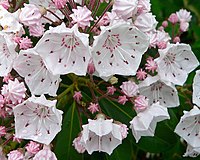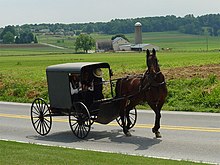Portal:Pennsylvania
The Pennsylvania Portal Pennsylvania (/ˌpɛnsɪlˈveɪniə/ , lit. 'Penn's forest country'), officially the Commonwealth of Pennsylvania (Pennsylvania Dutch: Pennsylvanie), is a state spanning the Mid-Atlantic, Northeastern, Appalachian, and Great Lakes regions of the United States. Pennsylvania borders Delaware to its southeast, Maryland to its south, West Virginia to its southwest, Ohio and the Ohio River to its west, Lake Erie and New York to its north, the Delaware River and New Jersey to its east, and the Canadian province of Ontario to its northwest. Pennsylvania was founded in 1681 through a royal land grant to William Penn, the son of the state's namesake. Prior to that, between 1638 and 1655, a southeast portion of the state was part of New Sweden, a Swedish Empire colony. Established as a haven for religious and political tolerance, the colonial-era Province of Pennsylvania was known for its relatively peaceful relations with native tribes, innovative government system, and religious pluralism. Pennsylvania played a vital and historic role in the American Revolution and the ultimately successful quest for independence from the British Empire, hosting the First and Second Continental Congress, leading to the adoption of the Declaration of Independence and the formation of the Continental Army. On December 12, 1787, Pennsylvania became the second state to ratify the U.S. Constitution. The bloodiest battle of the American Civil War, at Gettysburg over three days in July 1863, proved the war's turning point, leading to the Union's preservation. Throughout the late 19th and 20th centuries, the state's manufacturing-based economy contributed to the development of much of the nation's early infrastructure, including key bridges, skyscrapers, and military hardware used in U.S.-led victories in World War I, World War II, and the Cold War. Pennsylvania's geography is highly diverse. The Appalachian Mountains run through the center of the state; the Allegheny and Pocono mountains span much of Northeastern Pennsylvania; close to 60% of the state is forested. While it has no ocean shoreline, it has 140 miles (225 km) of waterfront along Lake Erie and the tidal Delaware River. (Full article...) This is a Featured article, which represents some of the best content on English Wikipedia..
 The Democratic Party primary for the 2010 United States Senate election in Pennsylvania took place on May 18, 2010, when Congressman Joe Sestak defeated incumbent Arlen Specter, which led to the end of Specter's five-term Senatorial career. Just before the start of the primary campaign, after serving in the Senate as a Republican for 29 years, Specter had switched to the Democratic Party in anticipation of a difficult primary challenge by Pat Toomey; Toomey ultimately defeated Sestak in the general election. Political observers and journalists described the race between Specter and Sestak as one of the bitterest and most-watched of all the 2010 primary elections. Although Sestak was initially urged to run by the Democratic establishment, Specter gained broad support from Democrats after he switched parties. Prominent political figures like President Barack Obama and Pennsylvania Governor Ed Rendell later tried to sway Sestak from continuing the race, fearing he would damage Specter's chances in the general election. Former President Bill Clinton offered Sestak a position in the Obama administration if he withdrew his candidacy, an offer Republicans would later criticize. Sestak refused to drop out and criticized Specter's party switch as an opportunistic move aimed solely at self-preservation. Nevertheless, Sestak struggled to overcome problems stemming from low name recognition and Specter's support from such individuals as Joe Biden and Harry Reid, and organizations like the AFL–CIO and Pennsylvania Democratic Committee. (Full article...)Selected geography article -Philadelphia, commonly referred to as Philly, is the most populous city in the U.S. state of Pennsylvania and the sixth-most populous city in the nation, with a population of 1,603,797 in the 2020 census. The city is the urban core of the larger Delaware Valley, also known as the Philadelphia metropolitan area, the nation's seventh-largest and one of the world's largest metropolitan regions with 6.245 million residents in its metropolitan statistical area and 7.366 million residents in its combined statistical area. Philadelphia is known for its extensive contributions to United States history, especially the American Revolution, and served as the nation's capital until 1800. It maintains contemporary influence in business and industry, culture, sports, and music. (Full article...)Selected image -Did you know -
Related portalsWikiprojectsThis is a Good article, an article that meets a core set of high editorial standards.
 Randolph Frederick Pausch (/paʊʃ/) (October 23, 1960 – July 25, 2008) was an American educator, a professor of computer science, human–computer interaction, and design at Carnegie Mellon University (CMU) in Pittsburgh, Pennsylvania. Pausch learned he had pancreatic cancer in September 2006. In August 2007, he was given a terminal diagnosis: "three to six months of good health left". He gave an upbeat lecture titled, "The Last Lecture: Really Achieving Your Childhood Dreams" on September 18, 2007 at Carnegie Mellon, which became a popular YouTube video and led to other media appearances. He co-authored a book of the same name, The Last Lecture, which became a New York Times best-seller. (Full article...)Selected article -The Amish (/ˈɑːmɪʃ/; Pennsylvania German: Amisch; German: Amische), formally the Old Order Amish, are a group of traditionalist Anabaptist Christian church fellowships with Swiss and Alsatian origins. As they maintain a degree of separation from surrounding populations, and hold their faith in common, the Amish have been described by certain scholars as an ethnoreligious group, combining features of an ethnicity and a Christian denomination. The Amish are closely related to Old Order Mennonites and Conservative Mennonites—denominations that are also a part of Anabaptist Christianity. The Amish are known for simple living, plain dress, Christian pacifism, and slowness to adopt many conveniences of modern technology, with a view neither to interrupt family time, nor replace face-to-face conversations whenever possible, and a view to maintain self-sufficiency. The Amish value rural life, manual labor, humility and Gelassenheit (submission to God's will). The Amish church began with a schism in Switzerland within a group of Swiss and Alsatian Mennonite Anabaptists in 1693 led by Jakob Ammann. Those who followed Ammann became known as Amish. In the second half of the 19th century, the Amish divided into Old Order Amish and Amish Mennonites; the latter do not abstain from using motor cars, whereas the Old Order Amish retained much of their traditional culture. When people refer to the Amish today, they normally refer to the Old Order Amish, though there are other subgroups of Amish. The Amish fall into three main subgroups—the Old Order Amish, the New Order Amish, and the Beachy Amish—all of whom wear plain dress and live their life according to the Bible as codified in their church's Ordnung. The Old Order Amish and New Order Amish conduct their worship in German, speak Pennsylvania Dutch, and use buggies for transportation, in contrast to the Beachy Amish who use modern technology (inclusive of motor cars) and conduct worship in the local language of the area in which they reside. Both the New Order Amish and the Beachy Amish emphasize the New Birth, evangelize to seek converts, and have Sunday Schools. (Full article...)Pennsylvania news
CategoriesState factsState Facts
State symbols
Pennsylvania topicsGeneral imagesThe following are images from various Pennsylvania-related articles on Wikipedia.
Associated WikimediaThe following Wikimedia Foundation sister projects provide more on this subject:
Discover Wikipedia using portals |


































































